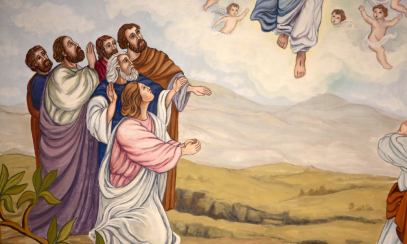What We Do is What We Believe
What is the difference between liturgy and devotions? why do we need both?
Liturgy is the official, public prayer of the Church the Body of Christ united with Christ its Head - as it praises and worships the Father, under the guidance of the Holy Spirit. Together, we celebrate the paschal mystery of Christ's passion, death, resurrection, and glorious ascension and our participation in it. This is so important that we need a whole liturgical year to explore this in all its facets. The Second Vatican Council reminded us that the liturgy is the summit toward which the activity of the church is directed and the fount from which all Her power flows (Constitution on the Sacred Liturgy, #10).
The Mass is our best-known liturgy. There are also liturgical rites for sacraments, funerals, blessings, and Communion outside Mass. The Liturgy of the Hours is the Church's official prayer of praise and petition whereby we consecrate the day to God.
Pray to our Father in secret: Our spiritual life is not limited to participation in the liturgy. We are called to pray with one another, but we are also called to pray to our Father in secret. (SC #12, cf. Mt 6:6). Sometimes, together or alone, we may engage in devotions. Devotions are external practices that are attached to particular titles for Jesus or Mary, saints, times, pilgrimage sites, places, insignia, medals or customs (Directory on Popular Piety and the Liturgy, 2001). They, too, help us enrich our relationship with the Trinity, Mary, or the saints.
Many devotions grew out of the time when the Mass was in Latin, Communion was infrequent, and architecture kept the people far removed from the altar. The faithful (often uneducated) invented simple prayers and practices to occupy themselves during liturgy. Other devotions developed in particular regions, first serving as powerful tools in evangelization, then lingering to sustain the faith of the people.
Our most famous devotions include the rosary (see page 23), Stations of the Cross, and prayers in honor of Our Lady of Perpetual Help and St. Joseph.
Novenas are prayers that are recited nine times or over nine days. This practice mimics the disciples nine days of prayer between the Ascension and Pentecost. There are novenas to the Holy Spirit, the Sacred Heart, Divine Mercy, Our Lady of Guadalupe, and others.
Top 6 reasons for devotions
From scholar Carl Dehne, SJ:
1 Devotions are characterized by their simplicity. They are often easily memorized and repeated. This can be especially helpful when one is alone or up in the middle of the night with a sick relative.
2 They develop a lively sense of the communion of the saints. Often litanies use personal titles to help the person associate with the saint, e.g., Mary, model of Mothers.
3 They establish a strong Catholic identity and allow a local church to express itself within its surrounding culture.
4 Since they have few rubrics, they help cultivate the emotions and deep spirituality of the believer.
5 They have a definite rhythm of prayer and conversation, often with small stops and starts.
6 With movement, singing, incense and other elements, they often (like the Liturgy) involve the whole body in prayer.
When used properly, devotions can be a great complement to the Church's liturgy, though they should never be merged with it nor substituted for it. They should be so fashioned that they harmonize with the liturgical season, accord with the sacred liturgy, are in some way derived from it and lead the people to it, since, in fact, the liturgy by its very nature far surpasses any of them (CSL 13).
Common Devotions
The Rosary
The Stations of the Cross
Novena to the Sacred Heart of Jesus
Chaplet of Divine Mercy
Novena to Our Lady of Guadalupe
Novena to the Holy Spirit
Devotions in Honor of Our Mother of Perpetual Help
Common Liturgies
Mass
Rite of Penance
Rite of Christian Initiation of Adults
Funerals
Liturgy of the Hours
Blessings
Rite of Distributing Holy Communion Outside of Mass
Timeline: the history of devotions
New Testament
Synagogue and home models of prayer are adapted; other cultural practices Christianized.
All things should begin and end with a thanksgiving. (1 Cor 10:31)
Invocations of Jesus repeated (Jesus, Son of David, have mercy on me; Jesus, remember me when you come into your kingdom).
Early Church
Not all prayer was public worship.
60 Didache directs people to pray the Lord's Prayer three times per day.
215 Apostolic Tradition records a variety of devotional practices including prayers at the various hours of the day and the sign of the cross.
Cult of martyrs develops, veneration of Mary.
4th century
Greater sense of sacred time and places.
Pilgrimages increase historicization of the passion and death of Christ; veneration of the cross.
Liturgical families develop; norms established for worship.
5th-6th centuries
Monastic communities arise; develop various penitential practices for personal, spiritual growth.
Gregory VII (590-604) establishes unity of Christian worship firmly rooted in Easter; other elements of paschal mystery commemorated; memorials of saints expanded.
7th-12th centuries
Development of the rosary as a substitute for the Psalter. (see page 23)
Emergence of religious orders; they compile prayers and devotions for their members.
Eucharistic adoration to compensate for less frequent reception of Communion.
Devotions to Mary and the saints; pilgrimages to the Holy Land and tombs of martyrs; veneration of relics.
Prayers for octaves (eight), novenas (nine), months (30) develop which are marginal to the liturgical year.
Popular piety integrated into the liturgy.
13th-15th centuries
Book of Hours printed in Latin and the vernacular; used by the wealthy and well-educated.
Repetition of psalm verses several times a day 2,606 verses = 150 psalms; alternative to a fast day.
1342 Franciscans take over custody of Holy Land shrines; encourage devotions to these places; series of shrines become commonplace in Europe, Stations of the Cross develop.
Devotio moderna meditative and affective pious exercises, such as The Imitation of Christ, become popular; less attention given to the communitarian, ecclesial, and liturgical aspects of prayer.
Council of Trent
In reaction to the spread of Protestantism, liturgical and sacramental questions were answered from a doctrinal perspective.
Reforms of the liturgical books (1568-1614) impose strict uniformity and a return to the ancient norms of the Fathers.
16th-20th centuries
Liturgy enters a static period, while popular piety enters a period of development.
Rise of confraternities - devoted to the mysteries of the Passion or the life of Mary; usually focused on penance, formation of laity, and works of charity.
Popular missions spread use of pious exercises; prayer manuals.
Pious exercises imposed within the liturgy; often characterized by a detachment from sacred Scripture or from the centrality of paschal mystery of Christ.
Single aspect of the paschal mystery or sacred time emphasized (e.g. devotion to the Sacred Heart of Jesus or First Friday).
1800s saw a return to Biblical and patristic studies and a renewed appreciation of all the baptized as the people of God. The aim of the renewal and reform of the liturgy was pastoral in nature.
Increased production of liturgical song as well as popular hymns; bilingual missals coincide with a proliferation of devotional booklets.
Miracles and apparitions; devotions at Marian sanctuaries and centers of pilgrimage; some eventually assumed into the liturgy.
Pius X emphasizes the superiority of liturgy over popular devotions; strives to make liturgy more accessible.
Vatican II
Restored the liturgy to the ideals of the early Fathers and removed many popular exercises from the liturgy.
Restored the emphasis on the word, the sacraments, and the paschal mystery of Christ.
Recognized the validity of popular exercises, but subordinated them to the liturgy.



